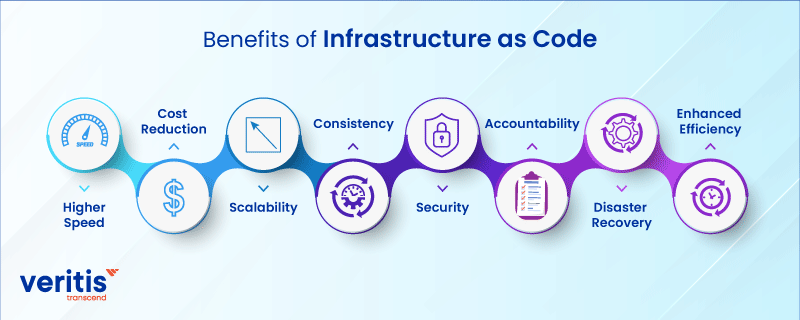
Companies of various sizes, both technical and non-technical, use the benefits of infrastructure as code (IaC). Hand-configuring your infrastructure is a thing of the past. Infrastructure is becoming more and more represented as code. HCL with Terraform, TypeScript with AWS CDK, or Python with Pulumi are a few examples.
This move to infrastructure as code is a quick-moving aspect. So, why is infrastructure as code growing in importance a legitimate issue? But why should a company or a product manager use their developer’s time to establish it?
IaC refers to managing and providing infrastructure using code rather than human procedures. Infrastructure as code is a higher-level abstraction that enables writing code or logging in a high-level language that uses modules to carry out operations at the machine level. Infrastructure as code tools uses code to provide, configure, and manage infrastructure.
Describe the infrastructure that the application runs on using the appropriate set of tools. The specification of virtual machines, storage, software stacks, network configurations, infrastructure as code security features, user accounts, access control thresholds, and other elements are all included.
What is Infrastructure as Code (IaC)?
Infrastructure as code, or IaC, provides and manages infrastructure through code instead of manually doing it. Infrastructure is described as code that enables users to efficiently distribute and update configurations while maintaining the infrastructure’s desired state. This implies that reproducible infrastructure setups are possible.
Types of Infrastructure in Code

IaC refers to managing your IT infrastructure with lines of code. There are four main types of infrastructure in code, and each is used in the appropriate situation:
1) Scripts
IaC can be expressed extremely simply with scripting. However, it is not advisable to utilize this type of IaC for complex operations, and it is often only used for straightforward or one-off tasks.
2) Provisioning Tools
In challenging activities, this kind of IaC provides additional benefits. By establishing infrastructure, these tools carry out automation. Developers use these IaCs to build infrastructure components. OpenStack Heat and AWS CloudFormation are two famous examples of specific provisioning tools.
3) Containers and Templating Tools
These programs create templates and images already pre-configured with all the necessary libraries and components to operate an application. Distributing data using these methods involves less administrative work than hosting an entire server. However, infrastructure as code security in containers can be a problem.
4) Configuration Management Tools
By setting up and configuring servers, these technologies implement automation. As they are specialized tools made to manage software, this kind of IaC is made for complex jobs. As a result, they are the most prevalent IaC; examples include Chef, Ansible, etc.
Useful link: Cloud Infrastructure Automation: The Imperative for Cloud Success!
Importance of Infrastructure as Code
There are two ways to use infrastructure as code, which must be established before we can examine how it functions. These techniques are known as declarative and imperative techniques.
The developer specifies the actions the IaC will take using the imperative manner to get the required results. This approach is structured around how an individual thinks. This method is simple and more effective because the user determines how the automation is carried out. Its main benefit is the ability to automate each step and layer of command, making it most effective for particular tasks.
The declarative method involves users describing the desired IT infrastructure solutions. And its final state while leaving the decision-making process to the infrastructure-as-code (IaC) system. Users specify the solution’s appearance and state, allowing IaC to determine the steps required to achieve it.
First and foremost, anyone can use IaC because it only requires a little prior knowledge on the user’s part. Second, this approach emphasizes IaC’s idempotent feature compared to the imperative method, which allows code to be executed repeatedly in any way as long as it produces the desired results.
Benefits of Infrastructure as Code

Your company can become more technologically savvy and productive by providing the benefits of infrastructure as a code. Adopting IaC can significantly impact your business, from lowering costs and providing more scalability to boosting infrastructure as code security and offering IT infrastructure solutions. So let’s analyze the benefits of infrastructure as code.
1) Higher Speed
Infrastructure as a code’s automation significantly speeds up the setup and configuration process. For any scenario, such as development, deployment, testing, production, and more, developers only need to run a script to set up their infrastructure. Your employees won’t have to wait for protracted setup or lose valuable time on complex configurations. A smoother application experience is made possible by increased speed, as are enhanced performance and responsiveness.
2) Cost Reduction
One of the primary advantages of using IaC is cost reduction. The first benefit of automating tasks is that you will spend less on human resources. For instance, a new employee’s hiring and onboarding are expensive. But the cost soars when you include pension, taxes, compensation, and office supplies.
Second, you can save money by not investing in and maintaining hardware for managing your infrastructure. IaC and cloud IT infrastructure services work hand in hand by choosing both. Finally, you can significantly save costs instead of completing monotonous tasks that an IaC tool can easily manage. For instance, your current employees may concentrate on attaining goals and pursuing innovation. You will be able to offer your staff members more challenging and fascinating per to do by relieving them of performing tedious tasks.
3) Scalability
Companies can provide the scalability required to keep their programs running by combining cloud IT infrastructure services with infrastructure as code tools. Modern application development is built on scalability, which is essential for growth and reputation preservation. The app’s user base may swiftly grow during high demand or rapid growth, which may cause delays and unavailability. This issue is resolved with automated scalability, which lets you expand and contract at your own pace without interruption.
4) Consistency
The decrease in human error is another benefit that makes IaC systems appealing. Teams can adopt a standardized infrastructure architecture to prevent any mishaps. Since physical labor is no longer required. IaC tools make infrastructure deployment reproducible and aid in removing threatening configuration drifts or missing dependencies. You can avoid conflicts and deviations and ensure a stable system by using configuration files as the sole source of truth.
5) Security
Consistency and security are ensured through IaC’s standardization and automation. Infrastructure as a code can use to record the proper technique to set up and manage the infrastructure. Version control, which enables secure and reversible modifications to the code, has another infrastructure as a code security advantage. The risk of unauthorized change is reduced because the changes are made in code rather than manually. As a result, version control allows for tracking, documenting, and reversing changes. Finally, since everything is codified and accessible to internal and external auditors, auditing is also made more accessible.
6) Accountability
Infrastructure as a Code enables elevated accountability through the transparency it provides. The system documents and defines everything in code, allowing easy tracking of the individuals responsible for changes, timing, and purpose. This streamline determining who made specific modifications and why, eliminating the need for extensive communication. By maintaining a reliable log system that captures every minor alteration, companies can enhance transparency, facilitate conflict resolution, save time, and encourage developers to implement necessary changes autonomously.
7) Disaster Recovery
Despite the best tools and skills, things can still go wrong for various reasons. Version control is a powerful tool that helps your business and offers a disaster recovery alternative. By simply reverting to the earlier version, well-maintained version control allows you to undo any recent modifications immediately. As a result, disaster recovery can save your company’s life, especially when it’s challenging to identify the problem’s leading cause immediately.
8) Enhanced Efficiency
IaC systems can contribute to the software development life cycle by enabling deployment at different phases. For instance, you can create a sandbox environment for developers to write code in isolation and test new concepts. QA professionals can also benefit from this technique by employing a clone of the production environment to run tests without affecting the actual code. In addition, you can now instantaneously deploy the app in a single step by sending both infrastructure and code to production. As a result, departments can operate concurrently without generating any disruption or conflicts of interest.
Useful link: IT Infrastructure Support to Staffing and Services Industry
Infrastructure as Code Best Practices
Although first adopting IaC can be rather tricky. However, some advice can make the process easier for you. The best practices that will permit you to benefit the most from IaC adoption are covered in this section.
1) Keep a Single Source of Truth
All infrastructure specifications are encoded in configuration files, which serve as the only reliable source of information for all infrastructure administration tasks. Therefore, avoid retaining additional paperwork that is kept separate from the source of truth to prevent errors and conflicts.
2) Develop Version Control
Create version control for all your configuration files and unify them in one place to avoid devastating outcomes if your application goes down.
3) Test and Monitor Configurations
IaC can and should be tested continually to prevent mistakes and inconsistencies since it is actual code. IaC tools can also provide systems enabling testing and monitoring choices. And let you validate the servers before going into production.
Conclusion
Infrastructure as code is a fundamental concept in IT that enables infrastructure managers to deploy resources, set up security, and modify the environment from any place rapidly and efficiently. Infrastructure as Code (IAC) is supported by nearly all top cloud providers, such as AWS, Google, and Microsoft Azure, as they offer dedicated services for managing IT infrastructure resources. In addition, you can use third-party IAC platforms like Terraform or Pulumi or declarative templates created from scratch to get started.
Veritis, the Stevie Award winner, embraces the benefits of infrastructure as code (IaC) for streamlined operations, efficiency, and scalability. Veritis achieves consistency, agility, and security with automated provisioning and configuration, optimizing costs and delivering reliable IT solutions.
Got Questions? Schedule A Call
Also Read:
- Why Is Remote Infrastructure Management Important for Businesses?
- Cloud Infrastructure Automation: The Imperative for Cloud Success!
- ‘Kubernetes-as-a-Service’ for Container Infrastructure
- Cloud Vs On-Premise: IT Infrastructure Model of Your Choice?
- IT Infrastructure Automation for Financial Operations
- IT Infrastructure in Mining Industry – Ease Business with Seamless Server Provisioning